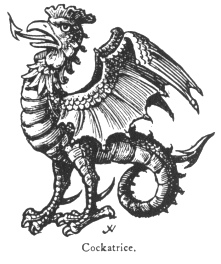
Masonic, Occult and Esoteric Online Library
Fictitious and Symbolic Creatures in Art
By John Vinycomb
Chimerical Creatures of the Dragon and Serpent kind - The Cockatrice
This chimerical creature was said to be produced from a cock's egg hatched by a serpent; hence its name. It differs from the wyvern of heraldry only in having a head like that of a dunghill cock. "This monster is of that nature," says an old writer, "that its look or breath is said to be deadly poison"; and this, in addition to the ordinary weapons of offence, would constitute it rather a difficult creature to be interfered with.
The cockatrice is frequently referred to in the Scriptures as the type of something evil. "The weaned child shall put his 
hand on the cockatrice's den" (Isaiah xi. 8), meaning that the most noxious animal shall not hurt the most feeble of God's creatures.
And Jeremiah viii. 17: "For behold, I will send serpents, cockatrices, among you which will not be charmed, and they shall bite you, saith the Lord."
The cockatrice is a frequent emblem in heraldry, borne as a charge upon the shield and also as a supporter. To the mailed draconic form of the wyvern it had the hideous crested head with livid dangling wattles similar to the dunghill cock, its round glittering eyes dealing death; its barbed tongue and serpentine tail, with deadly sting, would no doubt render it a fearful object to behold, and terrific to its enemies. It is always borne in profile, the wings endorsed, or back to back, unless directed otherwise. The tail is frequently nowed, i.e., knotted.
Sable, a cockatrice or, combed and wattled gules.—Bothe.
Sable, a cockatrice, displayed argent, crested, membered and jelloped gules.—Baggine.
Jelloped, jowlopped, terms used to describe the comb or crest, and gills or wattles, when of a different tincture from the body. Beaked and membered, in similar manner, have reference to the beak and legs.
